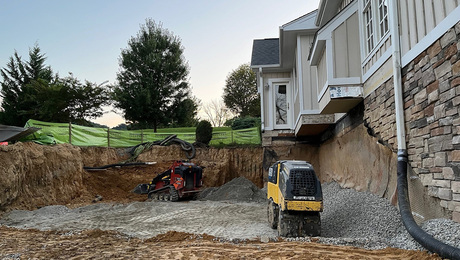What's the Difference: Cedar shingles
Tell me, sir, will that be red, white or perhaps an Alaskan yellow?

If building a house were as reliable as a textbook, you could nail up shingles of either red or white cedar and be assured your roof or exterior walls would enjoy life everlasting. On paper, the heartwood of both these cedars is extraordinarily durable and resistant to rot, even when left untreated. But what a wood scientist can prove in the lab seems a whole lot less certain in the field.
The shingle market these days is dominated by western red cedar (botanically speaking, that’s thuja plicata). Yet shingles from two other species also are widely available, at least regionally: northern white cedar (thuja occidentalis) and the less common Atlantic white cedar (chamaecyparis thyoides). And although red and white cedars have been the traditional standbys, you may even be able to find shingles of Alaskan yellow cedar (chamaecyparis nootkatensis) as well (photo below). As always, market choices are dictated by the availability of raw materials.
In the early days of coastal New England, builders chopped what was close at hand—stands of the swamp-dwelling Atlantic white. It grows in a narrow coastal zone extending from southern Maine to northern Florida and along the Gulf coast. Later, builders turned to northern white cedar, also called arborvitae. It has been prized by everyone from Indian canoe builders to French explorers who made a tea from its needles and bark to ward off scurvy. As lumbermen laid claim to the great forests of the Pacific Northwest, shingles made from the majestic western red cedar more or less took over the market.
The most obvious difference between the cedars is how they weather. White cedar starts out as a pale, straw brown and turns a silvery gray in time; the darker western wood has a much more reddish cast when new and can become almost black as it’s exposed to the sun and the rain. Yellow cedar is said to weather much like the white cedars.
R. Bruce Hoadley’s Understanding Wood (The Taunton Press, 1980) lumps cedar heartwood—red, white and otherwise—in a single category of “resistant or very resistant” to decay. Northern white and western red cedar have similarly low shrinkage rates: roughly 5% tangentially and 21⁄4% radially. Wood scientists at the Forest Products Lab in Madison, Wisconsin, agree that the heartwood of both red and white cedars should be roughly equivalent in durability and resistance to rot.
If these woods are both so great, why, then, does Liberty Cedar, a Rhode Island-based dealer (800-882-3327), warn that white cedar should not be used on a roof? Because, says Liberty’s Kurt Elmstrom, western red-cedar shingles still come from huge, tight-grained old growth trees. Vertical-grain cuts (in which growth rings are perpendicular to the face of the shingle) are readily available. That makes the wood more stable and less likely to cup or check. White-cedar shingles, says Elmstrom, are coming mostly from second-growth trees because the old-growth stuff is all but used up. Bundles of white-cedar shingles will contain more sapwood and more flat-sawn material, which is not as decay resistant.
As you might guess, white-cedar manufacturers sing a different tune. “A white-cedar roof is as good as red cedar,” says Roger Landry, product manager for shingles at a big Canadian lumber consortium called Sovebec (418-832-6181; www.sovebec.com). If white cedar is so crummy, Landry says, how come the white-cedar roof on his father’s Gaspé Peninsula house is in mint condition after 100 years? Sovebec’s “extra” grade of white-cedar shingles is made of vertical-grain heartwood, says Landry, and can be used on roofs or walls.
Regional loyalties notwithstanding, given a choice between old-growth western red cedar and second-growth eastern white cedar, wood specialists probably would vote red. White cedar is more commonly specified for walls when architects or builders want the old-time silvery look it gets with age. Its other advantage is price. Although prices vary regionally, top-grade western red-cedar shingles (No. 1 grade, “Blue Label”) that have been kiln-dried, rebutted and resquared can cost substantially more than northern white-cedar shingles of a comparable, but not identical, grade (grading rules are different for the two species).
Supplies of Alaskan yellow cedar are apparently limited, but shingles can be had (Liberty sells them, as does Bear Creek Lumber; 800-597-7191). This Pacific Northwest species is described by Donald Culross Peattie in his Natural History of Trees as “one of the least attractive trees among all conifers.” Ungainly as it might be on the stump, Alaskan cedar lumber and shingles are hard, light and highly resistant to rot. Elmstrom describes them as comparable to western red cedar in their decay resistance. Shingles come in cuts similar to those of western red cedar, and the material tends to be vertical grain and stable. For those old Yankees who still yearn for the pale color of white cedars, the availability of Alaskan cedar is good news—it, too, turns a silvery gray as it ages. Prices, says Elmstrom, are comparable to those for western red-cedar shingles.
Supplies of old-growth cedar are limited, and the wood has become entangled in U.S. forest politics. Most old-growth western red shingles are now coming from trees cut in Canada. Jon Arno, an authority on wood who regularly contributes to Fine Woodworking, says western red cedar is an extremely slow-growing tree. He fears that old-growth timber is now being cut so quickly that it will be out of the market by the year 2020. Old-growth Alaskan yellow cedar may face a similar fate.
A tale of three cedars
Shingles made from western red cedar are prized for their deep color and high resistance to rot. Alaskan yellow cedar offers the same durability but a lighter color. Northern white cedar has a loyal regional following.
Fine Homebuilding Recommended Products
Fine Homebuilding receives a commission for items purchased through links on this site, including Amazon Associates and other affiliate advertising programs.

Reliable Crimp Connectors

Handy Heat Gun

8067 All-Weather Flashing Tape





















